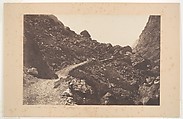Sentier du chaos, St-Sauveur
Joseph Vigier French
Not on view
In the summer of 1853, Viscount Vigier spent two months photographing in the Pyrenees. He had learned the waxed paper process from Gustave Le Gray but preferred Talbot's original technique for its strong contrasts of light and dark.
When Vigier exhibited his views in London and Paris in l854, they were highly acclaimed. These first photographs of the Pyrenees appealed to the English taste for the sublime and to the French romantic temperament. Their reception also benefited from the vogue for cures at mountain spas among the adventurous ailing. Few of the photographs in this rare album of twenty-four pages show tourist amenities, however; of the many views of gorges and peaks, the most impressive depict the Chaos of Gavarni, a vast, desolate amphitheater of raw rock.
This picture of sliding diagonals and unrelieved tension shows how powerfully Vigier could orchestrate his basic materials. He chose his vantage point so that the rock intruding on the footpath and the precarious boulder on the horizon would seem to be moving, still. Starkly contrasting sky and rock, Vigier's picture provides forceful evidence of a struggle so remote as to have occurred at the beginning of time--the geological chaos from which heaven and earth were born.
This image cannot be enlarged, viewed at full screen, or downloaded.

